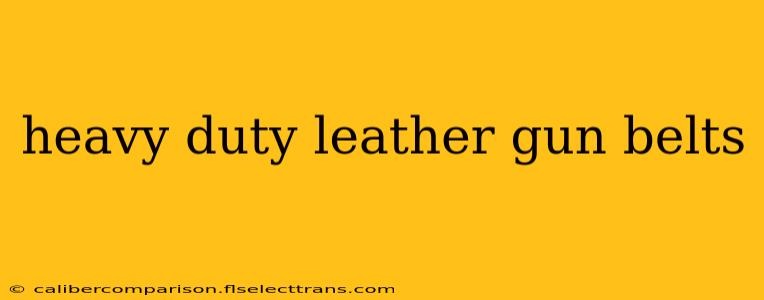Choosing the right gun belt is crucial for both concealed and open carry. A flimsy belt can lead to discomfort, printing (the outline of the firearm showing through clothing), and even unsafe sagging of your firearm. This guide will delve into the world of heavy-duty leather gun belts, helping you understand what to look for and how to choose the perfect one for your needs.
Why Choose a Heavy-Duty Leather Gun Belt?
Heavy-duty leather gun belts offer several advantages over nylon or other materials:
-
Durability: Leather, especially full-grain leather, is exceptionally durable. It can withstand daily wear and tear, providing long-lasting support for your firearm and other gear. A well-made leather belt will last for years, making it a worthwhile investment.
-
Stability: The stiffness of a quality leather gun belt provides the necessary rigidity to prevent sagging and ensure your firearm stays securely in place. This is essential for both comfort and safety.
-
Breathability: Unlike some synthetic materials, leather allows for better airflow, reducing discomfort, especially in warmer climates.
-
Appearance: Leather belts generally have a more refined and professional look than nylon belts, making them suitable for a variety of settings.
-
Moldability: Over time, a high-quality leather gun belt will mold to your body, offering a personalized and comfortable fit.
Key Features to Consider When Buying a Heavy-Duty Leather Gun Belt
Several factors contribute to the quality and performance of a heavy-duty leather gun belt. Pay close attention to these features:
1. Leather Type and Thickness:
- Full-Grain Leather: This is the highest quality leather, offering superior durability and longevity. Look for belts made from full-grain leather for the best performance.
- Thickness: A thicker belt (generally .125" or thicker) provides better support and rigidity. Thinner belts may not be suitable for heavier firearms or those carrying additional gear.
2. Stitching and Construction:
- Stitching: Look for belts with strong, double-stitched seams. This ensures the belt will hold up under stress. The stitching should be even and consistent.
- Construction: A well-constructed belt will have reinforced stitching at stress points and a sturdy buckle. Examine the belt carefully for any signs of poor craftsmanship.
3. Buckle Type:
- Solid Brass or Stainless Steel Buckles: These buckles are strong and durable, providing a secure closure. Avoid flimsy buckles that might break under pressure.
- Belt Loop System (for concealed carry): A belt loop system allows for smoother concealment, preventing the bulkiness of a large buckle from printing.
4. Belt Width:
- 1.5" - 1.75": This is a standard width for most gun belts, suitable for a variety of firearms and carry methods.
5. Sizing and Fit:
- Accurate Sizing: Order your belt based on your precise waist measurement. A belt that's too tight or too loose will be uncomfortable and may not provide adequate support.
- Proper Fit: Your belt should be snug but not overly tight. You should be able to comfortably buckle and unbuckle it.
Maintaining Your Heavy-Duty Leather Gun Belt
Proper care will extend the life of your leather gun belt. Here are some tips:
- Conditioning: Regularly condition your leather belt with a high-quality leather conditioner to keep it supple and prevent cracking.
- Cleaning: Clean your belt with a damp cloth and mild soap as needed. Avoid harsh chemicals.
- Storage: Store your belt in a cool, dry place away from direct sunlight.
Conclusion: Investing in Quality Matters
Investing in a high-quality, heavy-duty leather gun belt is an investment in your safety and comfort. By carefully considering the factors discussed above, you can choose a belt that will provide years of reliable service, ensuring your firearm remains secure and readily accessible. Remember, when it comes to concealed carry or open carry, a dependable gun belt is not a luxury; it’s a necessity.

